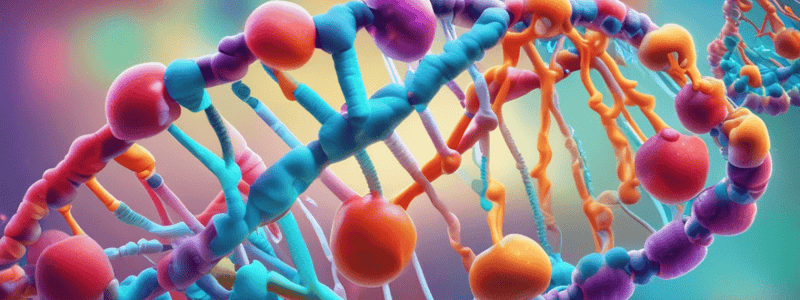Podcast
Questions and Answers
Which part of a nucleotide forms a covalent phosphodiester bond with another nucleotide?
Which part of a nucleotide forms a covalent phosphodiester bond with another nucleotide?
- Phosphate group
- Nitrogenous base
- Sugar (correct)
- Hydroxyl group
What is the function of most RNA in cells?
What is the function of most RNA in cells?
- Structural elements
- Regulatory functions
- Carrying instructions to make proteins (correct)
- Energy production
Which type of base has a double ring structure in nucleotides?
Which type of base has a double ring structure in nucleotides?
- Cytosine (C)
- Guanine (G) (correct)
- Thymine (T)
- Adenine (A)
In DNA, what are the bases attached to?
In DNA, what are the bases attached to?
What is the polymer with polarity that has different ends known as?
What is the polymer with polarity that has different ends known as?
Which type of nucleic acid is used as a structural element?
Which type of nucleic acid is used as a structural element?
What type of bonds is formed when nucleotides are polymerized?
What type of bonds is formed when nucleotides are polymerized?
What did James Watson and Francis Crick publish in the journal Nature in 1953?
What did James Watson and Francis Crick publish in the journal Nature in 1953?
Which feature of DNA's structure allows for precise base pairing?
Which feature of DNA's structure allows for precise base pairing?
How are the polynucleotide strands arranged in the Watson-Crick Model of DNA?
How are the polynucleotide strands arranged in the Watson-Crick Model of DNA?
How many hydrogen bonds form between C and G base pairs in DNA?
How many hydrogen bonds form between C and G base pairs in DNA?
What is found at one end of the double helix in DNA?
What is found at one end of the double helix in DNA?
Which statement is true about base pairing in DNA?
Which statement is true about base pairing in DNA?
What molecular feature of DNA is responsible for holding the double helix structure together?
What molecular feature of DNA is responsible for holding the double helix structure together?
Why is it essential for one base to be oriented 'upside down' relative to the other in DNA?
Why is it essential for one base to be oriented 'upside down' relative to the other in DNA?
Flashcards are hidden until you start studying
Study Notes
Nucleotides and Bonding
- The phosphate group of a nucleotide forms a covalent phosphodiester bond with the 3' hydroxyl group of another nucleotide.
- Nucleotides are polymerized through phosphodiester bonds, creating a long chain of nucleic acids.
RNA Function
- Most RNA in cells plays a crucial role in protein synthesis and acts as a messenger (mRNA), transfer RNA (tRNA), or ribosomal RNA (rRNA).
Nucleotide Structure
- Purines, which include adenine and guanine, are the bases that have a double ring structure in nucleotides.
- In DNA, the nitrogenous bases are attached to a deoxyribose sugar molecule.
DNA Polarity and Arrangement
- DNA is a polymer with polarity, characterized by a 5' end and a 3' end, allowing directional synthesis.
- The polynucleotide strands in the Watson-Crick Model of DNA are arranged in an antiparallel configuration.
Base Pairing and Stability
- Hydrogen bonds form between nucleotide bases during base pairing; specifically, three hydrogen bonds occur between cytosine (C) and guanine (G) base pairs.
- The feature of DNA's structure that allows for precise base pairing is its complementary base pairing mechanism.
Watson and Crick Contribution
- James Watson and Francis Crick published their model of the DNA double helix in the journal Nature in 1953.
Additional Features
- The double helix of DNA has a major and minor groove, with the double helix stabilized by hydrophobic interactions and hydrogen bonds.
- At one end of the DNA double helix, a phosphate group (5' end) is found, while the other end has a hydroxyl group (3' end).
- For proper base pairing in DNA to occur, it is necessary for one base to be oriented 'upside down' relative to the other, maintaining the antiparallel orientation of the strands.
Studying That Suits You
Use AI to generate personalized quizzes and flashcards to suit your learning preferences.



